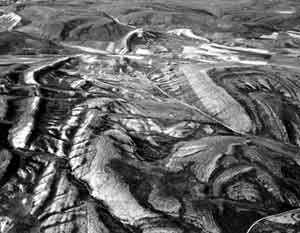|
Page
12
|
The
Wyoming Rockies and Basins
The country of
central Wyoming belongs to the stable North American craton, whose metamorphic
and igneous rock foundations crystallized in Archean time more than 2500 million
years ago. The topography of this area is controlled by mountain structures
made in the Laramide orogeny, 70 to 50 million years ago. Generally, the Laramide
orogeny consisted of large uplifts of Archean rocks of the Wyoming province,
which punched upward through their thin Paleozoic and Mesozoic sedimentary cover.
Examples include the Wind River Range, Owl Creek Mountains, Ancestral Teton
Range and Gros Ventre Range. In between the Laramide uplifts, basins subsided,
including the Green River and Wind River Basins, which now produce petroleum
and natural gas.
 |
| Folds in Jurassic rocks (mostly Twin Creek Formation) in the Crawford thrust sheet just west of Geneva, Idaho. Aerial view looks north, U.S. Highway 89 follows the transverse valley in middle distance, (august, 1984). |
Idaho-Wyoming
Thrust Belt
Near Fort Bridger
in southwestern Wyoming the Oregon Trail entered the Idaho-Wyoming thrust belt.
Today the thrust belt contains vast, largely unpopulated, forested mountains.
The area is underlain by a thick succession of sedimentary rocks that was deposited
off the subsiding edge of North America in Proterozoic, Paleozoic, and Mesozoic
time and then compressed, folded, and thrust as much as 100 miles eastward toward
the continent during the Sevier orogeny (about 130 to 55 million years ago in
late Mesozoic and early Tertiary time). The Idaho-Wyoming thrust belt is just
one segment of the Cordilleran thrust belt that contains folded and thrusted
sedimentary rocks along the North American Cordillera from Alaska south to Mexico.
Basin and Range
At Bear
Lake Valley the Oregon Trail entered the Basin and Range Province, an area affected
during the last ten million years by extensional forces, creating uplifted ranges
and downdropped valleys bounded by normal faults. The Basin and Range Province
overlaps the Idaho-Wyoming thrust belt in the area from Montpelier to Pocatello.
It extends northeast to Jackson Hole, west across southern Idaho to the Albion
Range and north across the Snake River Plain to east-central Idaho east of Mackay.
North of the Snake River Plain in east-central Idaho is the northern part of the Basin and Range Province, with the huge Lost River, Lemhi, and Beaverhead Ranges separated by the sparsely settled and arid Lost River, Little Lost River-Pahsimeroi, and Birch Creek Valleys.
Gateway
to the Snake River Plain
Along Interstate
15 and U.S. Highway 30, and the Union Pacific Railroad line, Portneuf Narrows
serves today as the gateway from the Basin and Range to the Snake River Plain.
Pocatello, at the mouth of Portneuf Narrows, is thus located at the junction
between the Basin and Range, Thrust Belt, and Snake River Plain. This
change in geologic structure is a fundamental cause for the major topographic,
climatic, and cultural change at Pocatello, from the agricultural valleys, flanked
by tree-covered mountains, of southeastern Idaho, to the open, windswept, irrigated
desert of the Snake River Plain.
Snake
River Plain Columbia Plateau Province
The Snake River
Plain-Columbia Plateau Province is a vast, relatively flat, but dry and rough
area of basalt and rhyolite lava erupted in the last 17 million years and today
cut by deep canyons.
Formation of the Snake River Plain began with inception of volcanic activity of the Snake River Plain-Yellowstone Hot Spot in southwestern Idaho about 17 million years ago. The origin of this volcanic activity is not well understood, but is probably related to a plume of heat from the Earth's mantle (a "Hot Spot"), which melted the lower crust and produced the lava which now covers much of southern Idaho.
South-Central Idaho and the Idaho Batholith Country